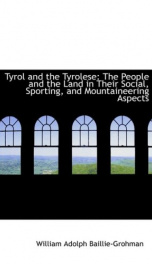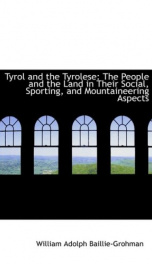tyrol

Purchase of this book includes free trial access to www.million-books.com where you can read more than a million books for free. This is an OCR edition with typos. Excerpt from book: CHAPTER IV. The Woodcutter. Though I have not laid special stress on the fact that Tyrol possesses certain characteristics not to be met with in other parts of civilized Europe, the reader will no doubt have gathered this from the remarks in the preceding chapter. The survival of an ancient type is in no class of the population so apparent as in the fraternity of the woodcutters. Cut off from the world, working in solitude amid the grandest of Alpine scenery, rough and uncouth in their exterior, inured to every danger, and hardy to quite an amazing degree, the "Holzhacker" affords a most interesting study not only for the artist, but also for those who delight in laying bare the vein of quaint originality mixed up with the other characteristics of a people untouched by that species of civilization which follows in the wake of tourists. The immense tracts of forest which are still to be found in the northern and centre districts ofTyrol, and which afford the staple resources of those parts, are generally speaking the property of the Crown. A large number of men are employed by Government in felling the timber, in cultivating new plantations, and in keeping in repair the huge wood- drifts which are established in these parts. From 3,000 to 4,000 men thus find sustenance in connexion with the "Forstwesen," or management of the forests, in Tyrol. These labourers are generally natives of neighbouring valleys, and in most cases they are younger sons of peasantsfarmers who own the land they tillwhose miniature homestead, consisting perhaps of a few acres of the very poorest soil, or a patch of meadow sufficient to keep three or four cows, proves inadequate to sustain an increasing family. The eldest son usually remains with the father, nominally inheriting the who...
Info about the book
Series:
Unknown
ASIN:
B004IIMCW4
Rating:
3/5 (5)Your rating:
0/5
Languge:
English
Users who have this book
Users who want this book
What readers are saying
What do you think? Write your own comment on this book!
write a commentif you like tyrol try:
Do you want to read a book that interests you? It’s EASY!
Create an account and send a request for reading to other users on the Webpage of the book!




